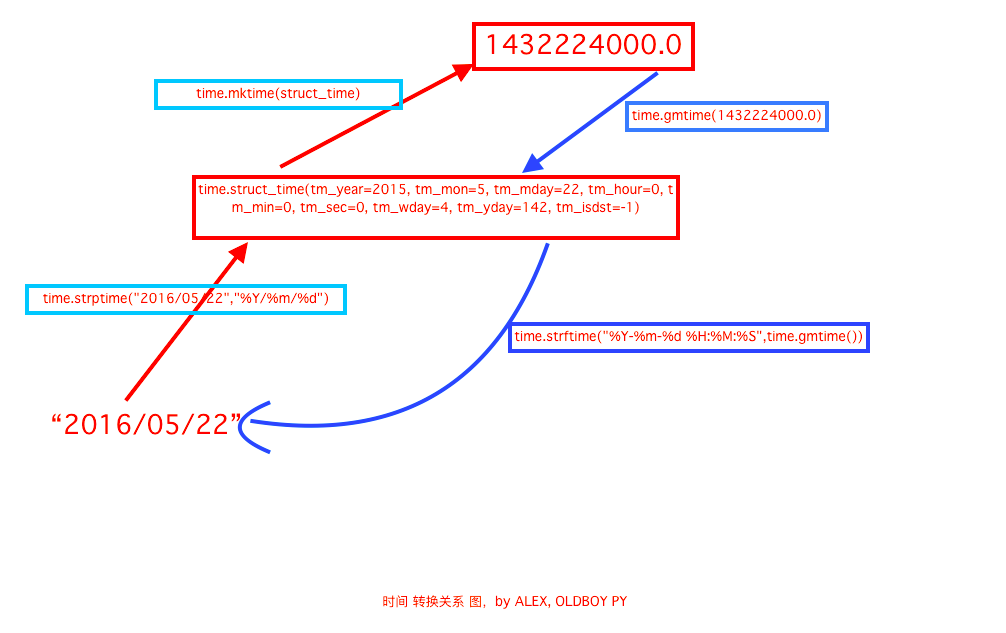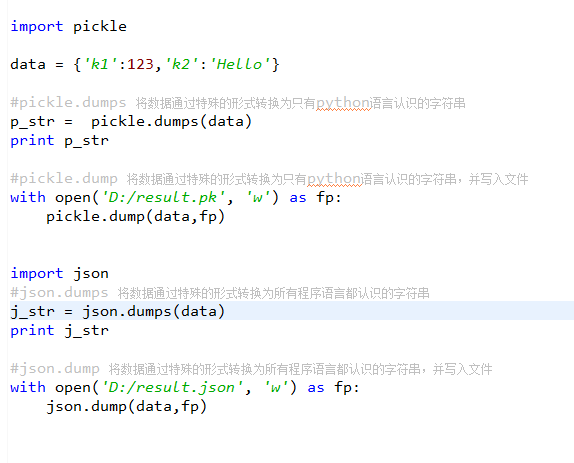py3.0第五天,常用模塊
本節大綱:
- 模塊介紹
- time &datetime模塊
- random
- os
- sys
- shutil
- json & picle
- shelve
- xml處理
- yaml處理
- configparser
- hashlib
- subprocess
- logging模塊
- re正則表達式
模塊,用一砣代碼實現了某個功能的代碼集合。
類似於函數式編程和面向過程編程,函數式編程則完成一個功能,其他代碼用來調用即可,提供了代碼的重用性和代碼間的耦合。而對於一個復雜的功能來,可能需要多個函數才能完成(函數又可以在不同的.py文件中),n個 .py 文件組成的代碼集合就稱為模塊。
如:os 是系統相關的模塊;file是文件操作相關的模塊
模塊分為三種:
- 自定義模塊
- 內置標準模塊(又稱標準庫)
- 開源模塊
自定義模塊 和開源模塊的使用參考 http://www.cnblogs.com/wupeiqi/articles/4963027.html
time & datetime模塊

1 #_*_coding:utf-8_*_ 2 __author__ = ‘Alex Li‘ 3 4 import time 5 6 7 # print(time.clock()) #返回處理器時間,3.3開始已廢棄 , 改成了time.process_time()測量處理器運算時間,不包括sleep時間,不穩定,mac上測不出來View Code8 # print(time.altzone) #返回與utc時間的時間差,以秒計算\ 9 # print(time.asctime()) #返回時間格式"Fri Aug 19 11:14:16 2016", 10 # print(time.localtime()) #返回本地時間 的struct time對象格式 11 # print(time.gmtime(time.time()-800000)) #返回utc時間的struc時間對象格式 12 13 # print(time.asctime(time.localtime())) #返回時間格式"Fri Aug 19 11:14:16 2016",14 #print(time.ctime()) #返回Fri Aug 19 12:38:29 2016 格式, 同上 15 16 17 18 # 日期字符串 轉成 時間戳 19 # string_2_struct = time.strptime("2016/05/22","%Y/%m/%d") #將 日期字符串 轉成 struct時間對象格式 20 # print(string_2_struct) 21 # # 22 # struct_2_stamp = time.mktime(string_2_struct) #將struct時間對象轉成時間戳 23 # print(struct_2_stamp) 24 25 26 27 #將時間戳轉為字符串格式 28 # print(time.gmtime(time.time()-86640)) #將utc時間戳轉換成struct_time格式 29 # print(time.strftime("%Y-%m-%d %H:%M:%S",time.gmtime()) ) #將utc struct_time格式轉成指定的字符串格式 30 31 32 33 34 35 #時間加減 36 import datetime 37 38 # print(datetime.datetime.now()) #返回 2016-08-19 12:47:03.941925 39 #print(datetime.date.fromtimestamp(time.time()) ) # 時間戳直接轉成日期格式 2016-08-19 40 # print(datetime.datetime.now() ) 41 # print(datetime.datetime.now() + datetime.timedelta(3)) #當前時間+3天 42 # print(datetime.datetime.now() + datetime.timedelta(-3)) #當前時間-3天 43 # print(datetime.datetime.now() + datetime.timedelta(hours=3)) #當前時間+3小時 44 # print(datetime.datetime.now() + datetime.timedelta(minutes=30)) #當前時間+30分 45 46 47 # 48 # c_time = datetime.datetime.now() 49 # print(c_time.replace(minute=3,hour=2)) #時間替換
| Directive | Meaning | Notes |
|---|---|---|
%a |
Locale’s abbreviated weekday name. | |
%A |
Locale’s full weekday name. | |
%b |
Locale’s abbreviated month name. | |
%B |
Locale’s full month name. | |
%c |
Locale’s appropriate date and time representation. | |
%d |
Day of the month as a decimal number [01,31]. | |
%H |
Hour (24-hour clock) as a decimal number [00,23]. | |
%I |
Hour (12-hour clock) as a decimal number [01,12]. | |
%j |
Day of the year as a decimal number [001,366]. | |
%m |
Month as a decimal number [01,12]. | |
%M |
Minute as a decimal number [00,59]. | |
%p |
Locale’s equivalent of either AM or PM. | (1) |
%S |
Second as a decimal number [00,61]. | (2) |
%U |
Week number of the year (Sunday as the first day of the week) as a decimal number [00,53]. All days in a new year preceding the first Sunday are considered to be in week 0. | (3) |
%w |
Weekday as a decimal number [0(Sunday),6]. | |
%W |
Week number of the year (Monday as the first day of the week) as a decimal number [00,53]. All days in a new year preceding the first Monday are considered to be in week 0. | (3) |
%x |
Locale’s appropriate date representation. | |
%X |
Locale’s appropriate time representation. | |
%y |
Year without century as a decimal number [00,99]. | |
%Y |
Year with century as a decimal number. | |
%z |
Time zone offset indicating a positive or negative time difference from UTC/GMT of the form +HHMM or -HHMM, where H represents decimal hour digits and M represents decimal minute digits [-23:59, +23:59]. | |
%Z |
Time zone name (no characters if no time zone exists). | |
%% |
A literal ‘%‘ character. |

random模塊
隨機數
mport random print random.random() print random.randint(1,2) print random.randrange(1,10)
生成隨機驗證碼
1 import random 2 checkcode = ‘‘ 3 for i in range(4): 4 current = random.randrange(0,4) 5 if current != i: 6 temp = chr(random.randint(65,90)) 7 else: 8 temp = random.randint(0,9) 9 checkcode += str(temp) 10 print checkcode
OS模塊
提供對操作系統進行調用的接口
1 os.getcwd() 獲取當前工作目錄,即當前python腳本工作的目錄路徑 2 os.chdir("dirname") 改變當前腳本工作目錄;相當於shell下cd 3 os.curdir 返回當前目錄: (‘.‘) 4 os.pardir 獲取當前目錄的父目錄字符串名:(‘..‘) 5 os.makedirs(‘dirname1/dirname2‘) 可生成多層遞歸目錄 6 os.removedirs(‘dirname1‘) 若目錄為空,則刪除,並遞歸到上一級目錄,如若也為空,則刪除,依此類推 7 os.mkdir(‘dirname‘) 生成單級目錄;相當於shell中mkdir dirname 8 os.rmdir(‘dirname‘) 刪除單級空目錄,若目錄不為空則無法刪除,報錯;相當於shell中rmdir dirname 9 os.listdir(‘dirname‘) 列出指定目錄下的所有文件和子目錄,包括隱藏文件,並以列表方式打印 10 os.remove() 刪除一個文件 11 os.rename("oldname","newname") 重命名文件/目錄 12 os.stat(‘path/filename‘) 獲取文件/目錄信息 13 os.sep 輸出操作系統特定的路徑分隔符,win下為"\\",Linux下為"/" 14 os.linesep 輸出當前平臺使用的行終止符,win下為"\t\n",Linux下為"\n" 15 os.pathsep 輸出用於分割文件路徑的字符串 16 os.name 輸出字符串指示當前使用平臺。win->‘nt‘; Linux->‘posix‘ 17 os.system("bash command") 運行shell命令,直接顯示 18 os.environ 獲取系統環境變量 19 os.path.abspath(path) 返回path規範化的絕對路徑 20 os.path.split(path) 將path分割成目錄和文件名二元組返回 21 os.path.dirname(path) 返回path的目錄。其實就是os.path.split(path)的第一個元素 22 os.path.basename(path) 返回path最後的文件名。如何path以/或\結尾,那麽就會返回空值。即os.path.split(path)的第二個元素 23 os.path.exists(path) 如果path存在,返回True;如果path不存在,返回False 24 os.path.isabs(path) 如果path是絕對路徑,返回True 25 os.path.isfile(path) 如果path是一個存在的文件,返回True。否則返回False 26 os.path.isdir(path) 如果path是一個存在的目錄,則返回True。否則返回False 27 os.path.join(path1[, path2[, ...]]) 將多個路徑組合後返回,第一個絕對路徑之前的參數將被忽略 28 os.path.getatime(path) 返回path所指向的文件或者目錄的最後存取時間 29 os.path.getmtime(path) 返回path所指向的文件或者目錄的最後修改時間
更猛的
https://docs.python.org/2/library/os.html?highlight=os#module-os
sys模塊
1 sys.argv 命令行參數List,第一個元素是程序本身路徑 2 sys.exit(n) 退出程序,正常退出時exit(0) 3 sys.version 獲取Python解釋程序的版本信息 4 sys.maxint 最大的Int值 5 sys.path 返回模塊的搜索路徑,初始化時使用PYTHONPATH環境變量的值 6 sys.platform 返回操作系統平臺名稱 7 sys.stdout.write(‘please:‘) 8 val = sys.stdin.readline()[:-1]
shutil 模塊
直接參考 http://www.cnblogs.com/wupeiqi/articles/4963027.html
json & pickle 模塊
用於序列化的兩個模塊
- json,用於字符串 和 python數據類型間進行轉換
- pickle,用於python特有的類型 和 python的數據類型間進行轉換
Json模塊提供了四個功能:dumps、dump、loads、load
pickle模塊提供了四個功能:dumps、dump、loads、load

shelve 模塊
shelve模塊是一個簡單的k,v將內存數據通過文件持久化的模塊,可以持久化任何pickle可支持的python數據格式
import shelve d = shelve.open(‘shelve_test‘) #打開一個文件 class Test(object): def __init__(self,n): self.n = n t = Test(123) t2 = Test(123334) name = ["alex","rain","test"] d["test"] = name #持久化列表 d["t1"] = t #持久化類 d["t2"] = t2 d.close()
xml處理模塊
xml是實現不同語言或程序之間進行數據交換的協議,跟json差不多,但json使用起來更簡單,不過,古時候,在json還沒誕生的黑暗年代,大家只能選擇用xml呀,至今很多傳統公司如金融行業的很多系統的接口還主要是xml。
xml的格式如下,就是通過<>節點來區別數據結構的:

<?xml version="1.0"?> <data> <country name="Liechtenstein"> <rank updated="yes">2</rank> <year>2008</year> <gdppc>141100</gdppc> <neighbor name="Austria" direction="E"/> <neighbor name="Switzerland" direction="W"/> </country> <country name="Singapore"> <rank updated="yes">5</rank> <year>2011</year> <gdppc>59900</gdppc> <neighbor name="Malaysia" direction="N"/> </country> <country name="Panama"> <rank updated="yes">69</rank> <year>2011</year> <gdppc>13600</gdppc> <neighbor name="Costa Rica" direction="W"/> <neighbor name="Colombia" direction="E"/> </country> </data>View Code
xml協議在各個語言裏的都 是支持的,在python中可以用以下模塊操作xml
import xml.etree.ElementTree as ET tree = ET.parse("xmltest.xml") root = tree.getroot() print(root.tag) #遍歷xml文檔 for child in root: print(child.tag, child.attrib) for i in child: print(i.tag,i.text) #只遍歷year 節點 for node in root.iter(‘year‘): print(node.tag,node.text)
修改和刪除xml文檔內容

import xml.etree.ElementTree as ET tree = ET.parse("xmltest.xml") root = tree.getroot() #修改 for node in root.iter(‘year‘): new_year = int(node.text) + 1 node.text = str(new_year) node.set("updated","yes") tree.write("xmltest.xml") #刪除node for country in root.findall(‘country‘): rank = int(country.find(‘rank‘).text) if rank > 50: root.remove(country) tree.write(‘output.xml‘)View Code
自己創建xml文檔

import xml.etree.ElementTree as ET new_xml = ET.Element("namelist") name = ET.SubElement(new_xml,"name",attrib={"enrolled":"yes"}) age = ET.SubElement(name,"age",attrib={"checked":"no"}) sex = ET.SubElement(name,"sex") sex.text = ‘33‘ name2 = ET.SubElement(new_xml,"name",attrib={"enrolled":"no"}) age = ET.SubElement(name2,"age") age.text = ‘19‘ et = ET.ElementTree(new_xml) #生成文檔對象 et.write("test.xml", encoding="utf-8",xml_declaration=True) ET.dump(new_xml) #打印生成的格式View Code
PyYAML模塊
Python也可以很容易的處理ymal文檔格式,只不過需要安裝一個模塊,參考文檔:http://pyyaml.org/wiki/PyYAMLDocumentation
ConfigParser模塊
用於生成和修改常見配置文檔,當前模塊的名稱在 python 3.x 版本中變更為 configparser。
來看一個好多軟件的常見文檔格式如下
[DEFAULT] ServerAliveInterval = 45 Compression = yes CompressionLevel = 9 ForwardX11 = yes [bitbucket.org] User = hg [topsecret.server.com] Port = 50022 ForwardX11 = no
如果想用python生成一個這樣的文檔怎麽做呢?
import configparser config = configparser.ConfigParser() config["DEFAULT"] = {‘ServerAliveInterval‘: ‘45‘, ‘Compression‘: ‘yes‘, ‘CompressionLevel‘: ‘9‘} config[‘bitbucket.org‘] = {} config[‘bitbucket.org‘][‘User‘] = ‘hg‘ config[‘topsecret.server.com‘] = {} topsecret = config[‘topsecret.server.com‘] topsecret[‘Host Port‘] = ‘50022‘ # mutates the parser topsecret[‘ForwardX11‘] = ‘no‘ # same here config[‘DEFAULT‘][‘ForwardX11‘] = ‘yes‘ with open(‘example.ini‘, ‘w‘) as configfile: config.write(configfile)
寫完了還可以再讀出來哈。

>>> import configparser >>> config = configparser.ConfigParser() >>> config.sections() [] >>> config.read(‘example.ini‘) [‘example.ini‘] >>> config.sections() [‘bitbucket.org‘, ‘topsecret.server.com‘] >>> ‘bitbucket.org‘ in config True >>> ‘bytebong.com‘ in config False >>> config[‘bitbucket.org‘][‘User‘] ‘hg‘ >>> config[‘DEFAULT‘][‘Compression‘] ‘yes‘ >>> topsecret = config[‘topsecret.server.com‘] >>> topsecret[‘ForwardX11‘] ‘no‘ >>> topsecret[‘Port‘] ‘50022‘ >>> for key in config[‘bitbucket.org‘]: print(key) ... user compressionlevel serveraliveinterval compression forwardx11 >>> config[‘bitbucket.org‘][‘ForwardX11‘] ‘yes‘View Code
configparser增刪改查語法

[section1] k1 = v1 k2:v2 [section2] k1 = v1 import ConfigParser config = ConfigParser.ConfigParser() config.read(‘i.cfg‘) # ########## 讀 ########## #secs = config.sections() #print secs #options = config.options(‘group2‘) #print options #item_list = config.items(‘group2‘) #print item_list #val = config.get(‘group1‘,‘key‘) #val = config.getint(‘group1‘,‘key‘) # ########## 改寫 ########## #sec = config.remove_section(‘group1‘) #config.write(open(‘i.cfg‘, "w")) #sec = config.has_section(‘wupeiqi‘) #sec = config.add_section(‘wupeiqi‘) #config.write(open(‘i.cfg‘, "w")) #config.set(‘group2‘,‘k1‘,11111) #config.write(open(‘i.cfg‘, "w")) #config.remove_option(‘group2‘,‘age‘) #config.write(open(‘i.cfg‘, "w"))View Code
hashlib模塊
用於加密相關的操作,3.x裏代替了md5模塊和sha模塊,主要提供 SHA1, SHA224, SHA256, SHA384, SHA512 ,MD5 算法

import hashlib m = hashlib.md5() m.update(b"Hello") m.update(b"It‘s me") print(m.digest()) m.update(b"It‘s been a long time since last time we ...") print(m.digest()) #2進制格式hash print(len(m.hexdigest())) #16進制格式hash ‘‘‘ def digest(self, *args, **kwargs): # real signature unknown """ Return the digest value as a string of binary data. """ pass def hexdigest(self, *args, **kwargs): # real signature unknown """ Return the digest value as a string of hexadecimal digits. """ pass ‘‘‘ import hashlib # ######## md5 ######## hash = hashlib.md5() hash.update(‘admin‘) print(hash.hexdigest()) # ######## sha1 ######## hash = hashlib.sha1() hash.update(‘admin‘) print(hash.hexdigest()) # ######## sha256 ######## hash = hashlib.sha256() hash.update(‘admin‘) print(hash.hexdigest()) # ######## sha384 ######## hash = hashlib.sha384() hash.update(‘admin‘) print(hash.hexdigest()) # ######## sha512 ######## hash = hashlib.sha512() hash.update(‘admin‘) print(hash.hexdigest())View Code
還不夠吊?python 還有一個 hmac 模塊,它內部對我們創建 key 和 內容 再進行處理然後再加密
散列消息鑒別碼,簡稱HMAC,是一種基於消息鑒別碼MAC(Message Authentication Code)的鑒別機制。使用HMAC時,消息通訊的雙方,通過驗證消息中加入的鑒別密鑰K來鑒別消息的真偽;
一般用於網絡通信中消息加密,前提是雙方先要約定好key,就像接頭暗號一樣,然後消息發送把用key把消息加密,接收方用key + 消息明文再加密,拿加密後的值 跟 發送者的相對比是否相等,這樣就能驗證消息的真實性,及發送者的合法性了。
import hmac h = hmac.new(b‘天王蓋地虎‘, b‘寶塔鎮河妖‘) print h.hexdigest()
更多關於md5,sha1,sha256等介紹的文章看這裏https://www.tbs-certificates.co.uk/FAQ/en/sha256.html
Subprocess模塊
py3.0第五天,常用模塊

